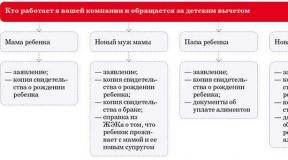Irrational functions. Basic elementary functions, their properties and graphs Graph of an irrational function examples
Knowledge basic elementary functions, their properties and graphs no less important than knowing the multiplication tables. They are like the foundation, everything is based on them, everything is built from them and everything comes down to them.
In this article we will list all the main elementary functions, provide their graphs and give without conclusion or proof properties of basic elementary functions according to the scheme:
- behavior of a function at the boundaries of the domain of definition, vertical asymptotes (if necessary, see the article classification of discontinuity points of a function);
- even and odd;
- intervals of convexity (convexity upward) and concavity (convexity downward), inflection points (if necessary, see the article convexity of a function, direction of convexity, inflection points, conditions of convexity and inflection);
- oblique and horizontal asymptotes;
- singular points of functions;
- special properties of some functions (for example, the smallest positive period of trigonometric functions).
If you are interested in or, then you can go to these sections of the theory.
Basic elementary functions are: constant function (constant), nth root, power function, exponential, logarithmic function, trigonometric and inverse trigonometric functions.
Page navigation.
Permanent function.
A constant function is defined on the set of all real numbers by the formula , where C is some real number. A constant function associates each real value of the independent variable x with the same value of the dependent variable y - the value C. A constant function is also called a constant.
The graph of a constant function is a straight line parallel to the x-axis and passing through the point with coordinates (0,C). For example, let's show graphs of constant functions y=5, y=-2 and, which in the figure below correspond to the black, red and blue lines, respectively.

Properties of a constant function.
- Domain: the entire set of real numbers.
- The constant function is even.
- Range of values: set consisting of the singular number C.
- A constant function is non-increasing and non-decreasing (that’s why it’s constant).
- It makes no sense to talk about convexity and concavity of a constant.
- There are no asymptotes.
- The function passes through the point (0,C) of the coordinate plane.
nth root.
Let's consider the basic elementary function, which is given by the formula , where n is a natural number greater than one.
Root of the nth degree, n is an even number.
Let's start with the nth root function for even values of the root exponent n.
As an example, here is a picture with images of function graphs ![]() and , they correspond to black, red and blue lines.
and , they correspond to black, red and blue lines.

The graphs of even-degree root functions have a similar appearance for other values of the exponent.
Properties of the nth root function for even n.
Root of the nth degree, n is an odd number.
The nth root function with an odd root exponent n is defined on the entire set of real numbers. For example, here are the function graphs ![]() and , they correspond to black, red and blue curves.
and , they correspond to black, red and blue curves.

For other odd values of the root exponent, the function graphs will have a similar appearance.
Properties of the nth root function for odd n.
Power function.
The power function is given by a formula of the form .
Let's consider the form of graphs of a power function and the properties of a power function depending on the value of the exponent.
Let's start with a power function with an integer exponent a. In this case, the appearance of the graphs of power functions and the properties of the functions depend on the evenness or oddness of the exponent, as well as on its sign. Therefore, we will first consider power functions for odd positive values of the exponent a, then for even positive exponents, then for odd negative exponents, and finally, for even negative a.
The properties of power functions with fractional and irrational exponents (as well as the type of graphs of such power functions) depend on the value of the exponent a. We will consider them, firstly, for a from zero to one, secondly, for a greater than one, thirdly, for a from minus one to zero, fourthly, for a less than minus one.
At the end of this section, for completeness, we will describe a power function with zero exponent.
Power function with odd positive exponent.
Let's consider a power function with an odd positive exponent, that is, with a = 1,3,5,....
The figure below shows graphs of power functions – black line, – blue line, – red line, – green line. For a=1 we have linear function y=x.

Properties of a power function with an odd positive exponent.
Power function with even positive exponent.
Let's consider a power function with an even positive exponent, that is, for a = 2,4,6,....
As an example, we give graphs of power functions – black line, – blue line, – red line. For a=2 we have a quadratic function, the graph of which is quadratic parabola.

Properties of a power function with an even positive exponent.
Power function with odd negative exponent.
Look at the graphs of the power function for odd negative values of the exponent, that is, for a = -1, -3, -5,....

The figure shows graphs of power functions as examples - black line, - blue line, - red line, - green line. For a=-1 we have inverse proportionality, whose graph is hyperbola.
Properties of a power function with an odd negative exponent.
Power function with even negative exponent.
Let's move on to the power function at a=-2,-4,-6,….

The figure shows graphs of power functions – black line, – blue line, – red line.
Properties of a power function with an even negative exponent.
A power function with a rational or irrational exponent whose value is greater than zero and less than one.
Note! If a is a positive fraction with an odd denominator, then some authors consider the domain of definition of the power function to be the interval. It is stipulated that the exponent a is an irreducible fraction. Now the authors of many textbooks on algebra and principles of analysis DO NOT DEFINE power functions with an exponent in the form of a fraction with an odd denominator for negative values of the argument. We will adhere to precisely this view, that is, we will consider the set to be the domains of definition of power functions with fractional positive exponents. We recommend that students find out your teacher's opinion on this subtle point in order to avoid disagreements.
Let us consider a power function with a rational or irrational exponent a, and .
Let us present graphs of power functions for a=11/12 (black line), a=5/7 (red line), (blue line), a=2/5 (green line).

A power function with a non-integer rational or irrational exponent greater than one.
Let us consider a power function with a non-integer rational or irrational exponent a, and .
Let us present graphs of power functions given by the formulas  (black, red, blue and green lines respectively).
(black, red, blue and green lines respectively).
For other values of the exponent a, the graphs of the function will have a similar appearance.
Properties of the power function at .
A power function with a real exponent that is greater than minus one and less than zero.
Note! If a is a negative fraction with an odd denominator, then some authors consider the domain of definition of a power function to be the interval ![]() . It is stipulated that the exponent a is an irreducible fraction. Now the authors of many textbooks on algebra and principles of analysis DO NOT DEFINE power functions with an exponent in the form of a fraction with an odd denominator for negative values of the argument. We will adhere to precisely this view, that is, we will consider the domains of definition of power functions with fractional fractional negative exponents to be a set, respectively. We recommend that students find out your teacher's opinion on this subtle point in order to avoid disagreements.
. It is stipulated that the exponent a is an irreducible fraction. Now the authors of many textbooks on algebra and principles of analysis DO NOT DEFINE power functions with an exponent in the form of a fraction with an odd denominator for negative values of the argument. We will adhere to precisely this view, that is, we will consider the domains of definition of power functions with fractional fractional negative exponents to be a set, respectively. We recommend that students find out your teacher's opinion on this subtle point in order to avoid disagreements.
Let's move on to the power function, kgod.
To have a good idea of the form of graphs of power functions for , we give examples of graphs of functions  (black, red, blue and green curves, respectively).
(black, red, blue and green curves, respectively).

Properties of a power function with exponent a, .
A power function with a non-integer real exponent that is less than minus one.
Let us give examples of graphs of power functions for  , they are depicted by black, red, blue and green lines, respectively.
, they are depicted by black, red, blue and green lines, respectively.

Properties of a power function with a non-integer negative exponent less than minus one.
When a = 0, we have a function - this is a straight line from which the point (0;1) is excluded (it was agreed not to attach any significance to the expression 0 0).
Exponential function.
One of the main elementary functions is the exponential function.
The graph of the exponential function, where and takes different forms depending on the value of the base a. Let's figure this out.
First, consider the case when the base of the exponential function takes a value from zero to one, that is, .
As an example, we present graphs of the exponential function for a = 1/2 – blue line, a = 5/6 – red line. The graphs of the exponential function have a similar appearance for other values of the base from the interval.

Properties of an exponential function with a base less than one.
Let us move on to the case when the base of the exponential function is greater than one, that is, .
As an illustration, we present graphs of exponential functions - blue line and - red line. For other values of the base greater than one, the graphs of the exponential function will have a similar appearance.

Properties of an exponential function with a base greater than one.
Logarithmic function.
The next basic elementary function is the logarithmic function, where , . The logarithmic function is defined only for positive values of the argument, that is, for .
The graph of a logarithmic function takes different forms depending on the value of the base a.
Maintaining your privacy is important to us. For this reason, we have developed a Privacy Policy that describes how we use and store your information. Please review our privacy practices and let us know if you have any questions.
Collection and use of personal information
Personal information refers to data that can be used to identify or contact a specific person.
You may be asked to provide your personal information at any time when you contact us.
Below are some examples of the types of personal information we may collect and how we may use such information.
What personal information do we collect:
- When you submit an application on the site, we may collect various information, including your name, telephone number, email address, etc.
How we use your personal information:
- The personal information we collect allows us to contact you with unique offers, promotions and other events and upcoming events.
- From time to time, we may use your personal information to send important notices and communications.
- We may also use personal information for internal purposes, such as conducting audits, data analysis and various research in order to improve the services we provide and provide you with recommendations regarding our services.
- If you participate in a prize draw, contest or similar promotion, we may use the information you provide to administer such programs.
Disclosure of information to third parties
We do not disclose the information received from you to third parties.
Exceptions:
- If necessary - in accordance with the law, judicial procedure, in legal proceedings, and/or on the basis of public requests or requests from government bodies in the Russian Federation - to disclose your personal information. We may also disclose information about you if we determine that such disclosure is necessary or appropriate for security, law enforcement, or other public importance purposes.
- In the event of a reorganization, merger, or sale, we may transfer the personal information we collect to the applicable successor third party.
Protection of personal information
We take precautions - including administrative, technical and physical - to protect your personal information from loss, theft, and misuse, as well as unauthorized access, disclosure, alteration and destruction.
Respecting your privacy at the company level
To ensure that your personal information is secure, we communicate privacy and security standards to our employees and strictly enforce privacy practices.
Basic elementary functions are: constant function (constant), root n-th degree, power function, exponential, logarithmic function, trigonometric and inverse trigonometric functions.
Permanent function.
A constant function is given on the set of all real numbers by the formula , where C– some real number. A constant function assigns each actual value of the independent variable x same value of the dependent variable y- meaning WITH. A constant function is also called a constant.
The graph of a constant function is a straight line parallel to the x-axis and passing through the point with coordinates (0,C). For example, let's show graphs of constant functions y=5,y=-2 and , which in the figure below correspond to the black, red and blue lines, respectively.

Properties of a constant function.
Domain: the entire set of real numbers.
The constant function is even.
Range of values: set consisting of a singular number WITH.
A constant function is non-increasing and non-decreasing (that’s why it’s constant).
It makes no sense to talk about convexity and concavity of a constant.
There are no asymptotes.
The function passes through the point (0,C) coordinate plane.
Root of the nth degree.
Let's consider the basic elementary function, which is given by the formula, where n– a natural number greater than one.
The nth root, n is an even number.
Let's start with the root function n-th power for even values of the root exponent n.
As an example, here is a picture with images of function graphs ![]() and , they correspond to black, red and blue lines.
and , they correspond to black, red and blue lines.

The graphs of even-degree root functions have a similar appearance for other values of the exponent.
Properties of the root functionn -th power for evenn .
The nth root, n is an odd number.
Root function n-th power with an odd root exponent n is defined on the entire set of real numbers. For example, here are the function graphs ![]() and , they correspond to black, red and blue curves.
and , they correspond to black, red and blue curves.
“Transformation of function graphs” - Stretching. Symmetry. Strengthen the construction of graphs of functions using transformations of graphs of elementary functions. Plotting graphs of complex functions. Independent work Option 1 Option 2. Parallel transfer. Match each graph with a function. Transformation of function graphs. Let's look at examples of transformations and explain each type of transformation.
“Irrational equation” - Algorithm for solving equations. History of unreasonable numbers. Which step in solving the equation leads to the appearance of extra roots. "Lesson-discussion". Find the mistake. Introduction. “Through equations and theorems, I solved a lot of different problems.” During the classes. In a dispute, insults, reproaches, and hostility towards your classmates are unacceptable.
“Graph of a function” - If a linear function is given by a formula of the form y = khx, that is, b = 0, it is called direct proportionality. If a linear function is given by the formula y = b, that is, k = 0, then its graph passes through the point with coordinates (b; 0) parallel to the OX axis. Function. A linear function is a function that can be specified by the formula y = kx + b, where x is the independent variable, k and b are some numbers.
How to graph a linear function? - The value of y at which x=3. Reinforcing the material covered. Methodological topic. Construct a graph of the linear function y=-3x+6. - Determine the properties of this function. Check: Student at the blackboard. Study of functions. In writing with verification. Within the scope of the school curriculum.
“Graph of the function Y X” - Example 1. Let’s build a graph of the function y=(x - 2)2, based on the graph of the function y=x2 (mouse click). To see the graphs, click the mouse. Example 2. Let's build a graph of the function y = x2 + 1, based on the graph of the function y=x2 (mouse click). Parabola pattern y = x2. The graph of the function y=(x - m)2 is a parabola with its vertex at the point (m; 0).
“Irrational equations and inequalities” - Methods of solution. 3. Introduction of auxiliary variables. 1. Exponentiation. Irrational equations Methods of solution. Irrational equations and inequalities. 2. Multiplication by the conjugate expression. 4. Selecting a complete square under the radical sign. 6. Graphic method. Irrational inequalities.



















